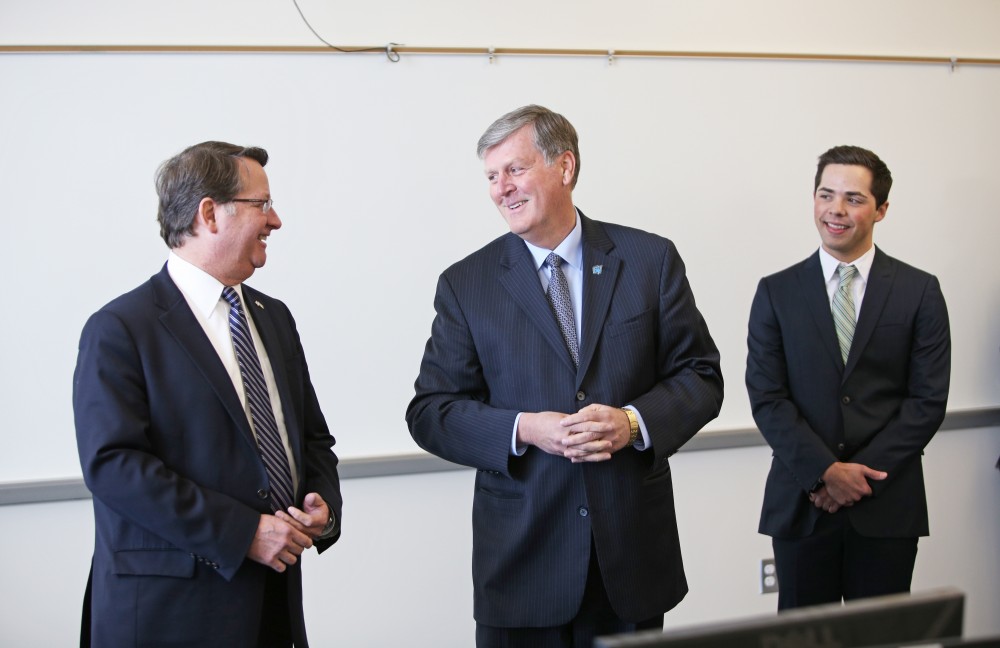Haas asks state Senate for increased funding

GVL/Kevin Sielaff U.S. Senator Gary Peters with GVSU President Thomas Haas and Student Senate President Andrew Plague
Mar 26, 2015
Grand Valley State University President Thomas J. Haas presented to the Higher Education Subcommittee of the Senate Committee on Appropriations on March 18 in Lansing. He advocated for the increase of state funding based on performance, and the additional measurement of enrollment for state appropriation of funds.
All performance-based funding GVSU has received in the past three years has been given back to students as financial aid, Haas said. This includes the “Grand Finish” program, which offers students who complete 90 credits in three years a nearly 10 percent tuition discount in their senior year.
However, he said only seven percent of funding is awarded through performance metrics.
“Today’s students and families deserve the benefits that improved performance brings, so I encourage you to speed the pace toward more performance testing,” Haas told the Senate.
Haas also encouraged the Senate to include student enrollment as a factor in the appropriations process.
“We have been perennially disadvantaged because we’ve grown,” he said.
GVSU underwent a 62.5 percent increase in enrollment from 1998 to 2013 – the highest of any public university in the state. In the past 30 years, GVSU has seen a 20.9 percent decrease in appropriation per student, the only decrease among public universities in Michigan.
“This is a stunning slide,” Haas said.
The GVSU student headcount in fall 2014 ranked fourth highest in the state, but GVSU ranked last in appropriation per student in the 2014-2015 academic school year. The university also ranked last in state investment per degree in 2013, at roughly half the state average.
“It is irrational to continue a state budget practice penalizing campuses that grow while rewarding campuses that shrink,” Haas said.
Vice President for University Relations Matt McLogan said an increase in state funding could help lower tuition for GVSU.
“When we get more of one, we get less of the other,” McLogan said. “But lately things have been running in the other direction.”
This could be accomplished if GVSU were funded at the average of all Michigan schools, he said.
In spite of GVSU’s high retention, high graduation rates, low operating costs, Pell grant eligibility and degrees awarded in STEM fields and health professions, the burden has been placed on students and their families to displace the lack of state funding, McLogan said.
“There’s a big difference between the university’s quality and the state funding,” he said.
GVSU’s Student Senate President Andrew Plague joined President Haas in his testimony before the state Senate. The university hopes his presence, on behalf of the student body, will help show senators that “money means students,” Plague said.
“They want the lawmakers to remember what we’re talking about, so it’s not this abstract notion of the institution,” he added.
The Student Senate is encouraging more students to get involved. On April 16, in the Kirkhof Center on the Allendale Campus, students can look up and email their senators, requesting the support of funding for higher education.
“The student voice is so important, because 94 percent of our students are Michigan residents,” Haas said. “Michigan senators should hear from the students.”
More information on GVSU’s performance and funding can be found in the Accountability Report, located on GVSU’s website at
www.gvsu.edu/cms3/assets/B8910F19-F21C-4F0E-A914E28DFD89C2BA/141023_accountability_report_official_web.pdf.

























